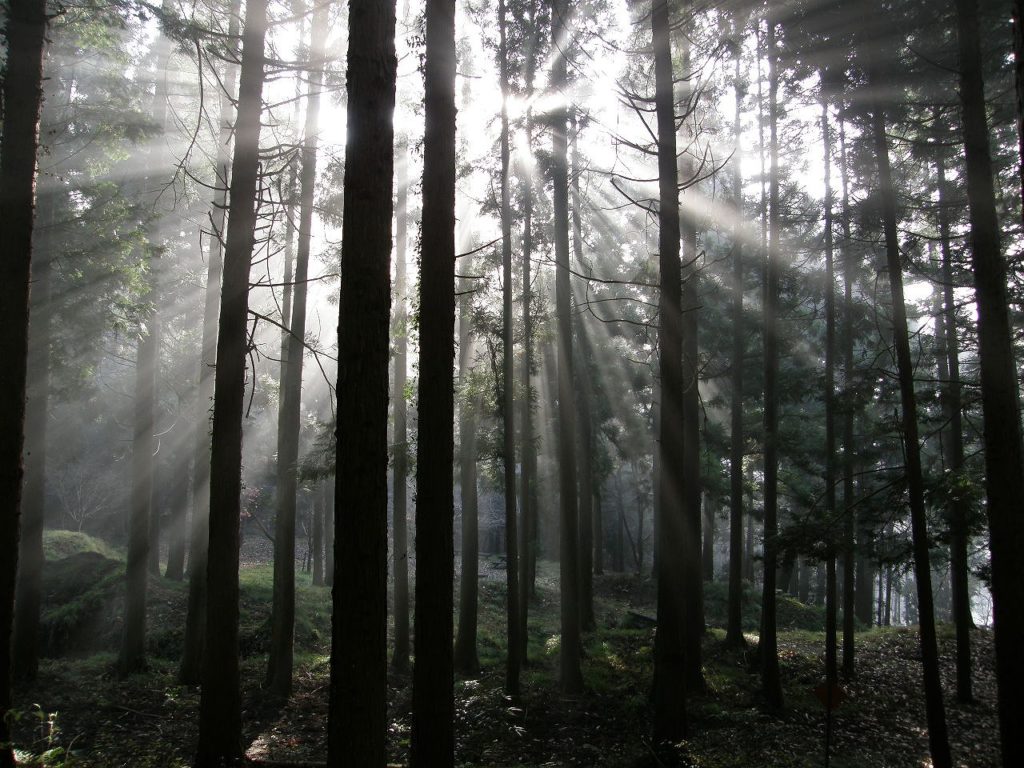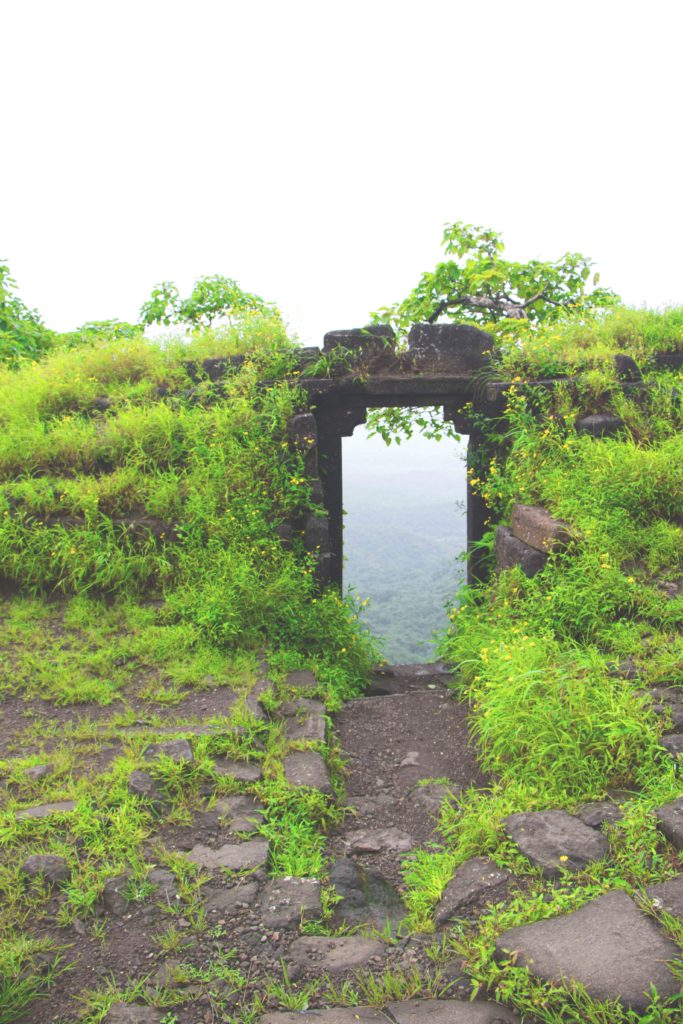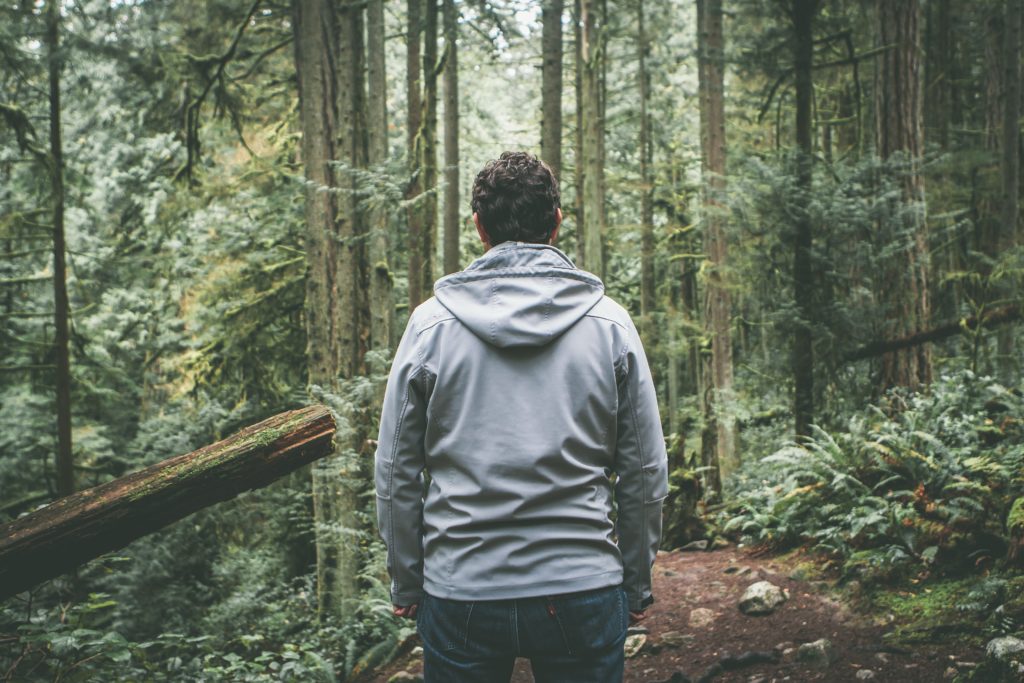

Features
Forest Bathing and the Larger Implications of Accessible Nature
Terrapin Bright Green
Share
By Julia Kane Africa
Where abiotic cityscapes and social services were once tasked with health and resilience, their role is increasingly matched (and occasionally eclipsed) by the perceived contribution of environmental quality and green space. Biotic agents include but are not limited to restorative landscapes (thought to influence health through sensory awareness of composition and programming); biodiversity (flora, fauna and associated microbial agents thought to influence immunology, digestion and mental health) 1; phytoncides (bioactive aerosols produced by plants that are implicated as causal agents in most ‘forest bathing’ research from Asia) 2; and the use of tactical biophilic design techniques 3 to extend neurobiological exposure to salutogenic natural environments from the outdoors into the indoor settings where we spend the majority of our lives. When we consider the future of urban adaption, dynamic synergies with biotic built environment features coupled with tactical use of park exposures are necessary to support human survival in the disruptions of the Anthropocene. In this essay, I will reflect on trends in the practice of ‘forest bathing’, with special attention to how popular interest in the US is spurring an evolution in the understanding of links between personal, communal, and ecological wellbeing.
Bringing Nature into Our Cities
By 2050, 75 percent of the world’s projected 9 billion people will live in cities and, in all likelihood, face significantly degraded environmental quality. Elevated incidence and duration of high heat coupled with increased air pollution and higher pollen counts are projected to increase deaths dues to respiratory and cardiovascular illness. Though not a replacement for well-maintained infrastructure and competent civic organizations, investing in urban ecosystem services will help attenuate these threats 4. Planners are increasingly attuned to the social, emotional and cognitive benefits of using nature and natural design cues.
Planners are increasingly attuned to the social, emotional and cognitive benefits of using nature and natural design cues.”
As Tim Beatley has written, a biophilic city is one that “puts nature first in its design, planning, and management; it recognizes the essential need for daily human contact with nature” 5 at regional, municipal, building and resident-specific scales, ideally in a way which mimics the richness and interconnected vibrancy of an ecosystem. When we think about landscape holistically – ecologies and biomes as the supportive framework within which we live and breathe, with streets and social networks and commerce as interstitial tissues determining flows – we rediscover through biophilic design an expression of space, place and time that is authentic. In an era increasingly characterized by displacements from geographical refugees to digital nomads with opaque identities, authenticity is at the heart of social medicine and trees are agents of authenticity in the public realm.
Medicinal Trees
Trees and forests have particularly well documented health benefits in urban settings. A recent study 6 found that street trees, in particular, had more impact on perceived benefits to health and well-being than private backyards or courtyards; this startling finding, coupled with their well known role in creating more temperate microclimates and filtering urban pollutants, reinforces the critical contribution 7 of public canopies to equitably healthy urbanism. Whether through heat mitigation, contaminant filtration, structural formation, or psychological fixation, the discrete value propositions represented by trees elide appealingly and present a clear case for their respectful incorporation into our urban lives.

A stand of Hinoki, or Japanese Cypress. Image copyright 陳炬燵/Wikimedia.
At the frontiers of biotic design practice, a Janus-faced orientation is necessary to grasp the different ways in which trees can be understood as influencing health in urban environments. From the past, where pre-modern medical traditions informed the use of and reverence for certain plants, we can turn towards speculative modern practice to describe how medicinal plants contribute to healthy urbanism through the synergy of social narrative, physical structure and biochemical emissions. Trees are used in medicinal contexts the world over. In Japan, mature stands of Hinoki and Sugi are thought to emit beneficial phytoncides that lower blood pressure, increase production of Natural killer (NK) cells, and improve mood 8. Those same stands might be logged in another setting through an ancient practice whereby trees are scaled and the bark stripped in sheets, leaving the exposed wood to ‘cure’ while weeping phytoncide-rich resins for three days until they are felled. This artisanal method of timbering seems not to have aroused so much as a raised eyebrow from forest therapy researchers; in this example, an occupational exposure beyond the bounds of a culturally bounded healing space is not assumed to be medicinal. Neem trees are the local ‘pharmacies’ of many rural Indian communities, supplying everything from soap to anti-parasitic compounds to bug-resistant thatching. The primacy of the tree is most evident in hospital courtyards where patients were once directed to recuperate beneath their leafy boughs. In Finland, stands of birches supply everything from the switches used in saunas to medicinal teas to soothing glades in therapeutic “Power Forests.” These are but a few of many examples of the ways in which trees are believed to contribute to health, all informed by local practices, beliefs about the body, and cultural attitudes towards nature.
Forest Therapy Programs in Asia
The unforgiving hardscape of many urban centers drives nature-therapy hungry residents to the hinterlands in search of restoration. Park prescription programs have taken off worldwide, with precedents in Asia serving as models for the integration of forests into national healthcare practice. In Japan, the Ministry of Agriculture, Forestry, and Fisheries developed the term “shinrin-yoku” or “forest bathing” in 1982 to describe “making contact with and taking in the atmosphere of the forest” 9; today, shinrin-yoku is practiced at 62 Forest Therapy Bases (FTB), with as many as 100 ultimately envisioned across the archipelago. As with any successful practice, it thrives precisely because it has a culturally deep and economically distributed support system 10. For centuries, complex systems of silviculture were used to nurture groves of Sugi and Hinoki cypress trees, among others, to meet the colossal needs of Japan’s ceremonial and vernacular architecture. As a result, the midori no rettô (or “green archipelago”), which might have become a barren wasteland, instead developed rigorous collective management strategies to preserve forest stocks for sustainable harvest and watershed protection. The architectural emphasis on aromatic woods with distinctive grains created a culture that privileged the sensory contributions of trees.
The architectural emphasis on aromatic woods with distinctive grains created a culture that privileged the sensory contributions of trees.”
In the 20th century, Japan’s need for forest products was increasingly (and unsustainably) outsourced to its Asian neighbors and beyond. Efforts to stoke interest in well-managed native stock led the Forestry and Forest Products Research Institute to conduct research in the late 1970s and 1980s into phytoncides. These compounds are produced by live trees as defensive or signaling agents but are also present in resin and have been associated with improvements to mood, immune function, and blood pressure. Mature aromatic Sugi and Hinoki forests, like those found at the FTB in Nagano prefecture, are among those considered rich in bioactive compounds and thus ideal for therapeutic exposure. Each base develops an identity rooted in its most prominent characteristic; while this is often related to local forests (as the name would imply), other settings (i.e. steeply terraced rice paddies) are included if they compliment a restorative aesthetic.
More compelling still is the way in which access to bases is facilitated by partnerships. Not all bases track the demographics of visitors, but those that do report two broad categories of attendance: older retirees whose goals include fitness, leisure, and socialization; and workers, predominantly younger and female, who attend through subsidized shain ryoko or company trips. In some cases, visits may include optional “health checks,” which range from complementary therapies (including dietary management, “forest yoga,” and aromatherapy) to biometric tests like blood pressure and heart rate. The “health checks” are not standardized across or within bases, and the data is rarely transmitted to external medical practitioners. Concerns about proven clinical efficacy or employee privacy do not prevent companies from supporting visits. Indeed, municipalities often partner with companies, reinforcing connections between modes of production and regional talent or resources. The Linan FTB has agreements with 25 companies and organizations including Nissan Motor Company, Ltd., and Mazda Motor Corporation. Other bases reported partnerships with a policeman’s union, a juku or “cram school,” and a music conservatory. In Japan, local populations and those who have a subsidized attendance through a company or clinic are most likely to visit an FTB.
As sometimes happens in history, a terrible event can be the genesis of something ultimately wonderful. The Japanese occupation of Korea in 1910 stripped mountain flanks of timber, and subsequent wars reduced what remained as people scavenged for fuel. Reforestation started in earnest in 1960, where nearly 2.5 million individual Hinoki trees planted in the Jangseong forest alone because of their speedy growth and pest resistance 11. Half a century later, Jangseong is a jewel in a network of national forests linked by one of the most ambitious forest medicine programs in the world. The Law on Forest Welfare Promotion was enacted in 2015 by the National Assembly to provide an institutional base for promoting systematic forest welfare services customized by life stage from cradle to grave. These services include but are not limited to cultural, recreational, educational, and therapeutic services rendered through woodcrafts, forest kindergartens, camping facilities, therapeutic hikes, tree burial, and so on at 34 national healing forests, with two additional national forest healing centers slated to open this year. The Korea Forest Service is also tasked with facilitating the training of 500 “Forest Healing” instructors and plans generate comprehensive medical research on forest healing through interdisciplinary approaches with a shared database across the 34 sites 12.
Finding American Approaches to Forest Bathing
Back in the US, popular enthusiasm for the health benefits of time in nature has grown exponentially; proponents have gone so far as to describe the forest bathing trend as analogous to “where Yoga was 30 years ago” 13. Federal and State agencies, professional groups, non-profits and insurers are among those that actively support initiatives to connect people with nearby nature through education, recreation, and parks prescription programs 14. However, a critical difference in our American experience as compared with other developed countries is the lack of a centralized administrative organization or authority charged with consolidating research and guiding the integration of therapeutic natural areas into managed care protocols. As is evident from our ongoing national struggle with the Affordable Care Act, the Federal government can mandate that all citizens have health insurance, but they cannot structure implementation; accordingly, support for nature therapies in subsidized clinical practice varies among care regimes and providers. It is heartening to note progressive examples like the Green Road project 15 where forest settings are included in treatment protocols at one of the leading US military trauma treatment centers.
The theme of ‘access to nature for health’ has been taken up by ad hoc partnerships in many different settings. Clinicians, insurers and employers interested in a crisp ‘dose-response’ relationship or a ‘return on investment’ analysis have had to content themselves with a somewhat fuzzy yet consistent value proposition, one that is initially (in some quarters) distinctly foreign. They find a willing partner in the US National Park Service’s Healthy Parks Healthy People program which works tirelessly to advance the role of parks, public lands, and waters in promoting health 16.
Nature and health programs can struggle with perceptions of exclusivity. The diversity of the American population means that we come to nature from a wide variety of cultural, linguistic and historical backgrounds. Although forest bathing is often compared to Yoga because both practices foster contemplative time and restorative movement, the analogy is misleading for two reasons. First, while Yoga is notionally suitable for anyone, it’s often practiced in this country as part of a bespoke wellness regimen that is not available to everyone. Second, the deep spiritual teachings embedded in the practice of yoga are often obscured by a popular culture of wellness and commodification; while it is possible that therapeutic exposure to nature will develop in this way, it would be much diminished.
There may, however, be one unexpected way in which Yoga and forest bathing have a similar orientation. Patanjali’s yoga sutras tell us that “when the fluctuations of consciousness cease we have the experience of our true nature.” The sutras refer to the drastuh, or ‘witness consciousness,’ as achieved through release of attachment to our minds, bodies and emotions, allowing us to embody our true nature and prepare for death 17 (a practice addressed in the Bhagavad Gita as “closing the gates”). Put another way, the Dalai Lama is quoted as having said “awareness of death is the very bedrock of the path. Until you have developed this awareness, all other practices are useless.” This deep soul work is also very well facilitated by the ageless and expansive qualities of time in nature. At this moment in history, any terrain that you have had the gift of knowing becomes your Walden Pond, and you may be aware of your capacity to witness the ecological changes great and small, including extinction, like Thoreau. To paraphrase Baba Dioum’s famous quote, “In the end we will conserve only what we love; we will love only what we understand;” and to understand something, we must strive to release ourselves and know it on its own terms. We must fend off the reduction of mindfulness practices to just another expression of personal fitness, because the world badly needs both witnesses as well as champions.
We must fend off the reduction of mindfulness practices to just another expression of personal fitness, because the world badly needs both witnesses as well as champions.”
Likewise, insofar as biophilic design is ambient in a culture of wellness linked with privilege, the practice must not relinquish its power to create true change in human experience and embody ‘right conduct’ through design that sensitively integrates site ecology and sustainability. Perhaps most importantly, it must continue to expand its reach as an approach that accommodates individuals and communities of all socio-economic backgrounds, dispositions, and abilities. In addition to more traditional health services, the availability of safe, accessible, and well-maintained nearby nature is a critical component of environmental and social health, one that should by right be available to every resident.
Building Resilience Through Access to Nature
Cultivating resilience is a key buzzword in all professions that are alert to the looming specter of climate change, but it provides particularly fertile ground for the meeting of Forestry Science and applied Public Health. From the international community, we can observe the integration of forests into perceptions and practices related to health; the character of our own national experience is still evolving. Biophilic design differs from but corresponds to the same impulses that spur interest in forest bathing: a concern for personal and communal wellness, ecology, and resilience in the face of climate change. Climate change-related disruptions in plant metabolism and behavior, including CO2 exchange rates, nutritional content and production of allergic agents (pollens, atopic irritants), will shake our foundational reliance on ecosystem services and therapeutic nature. At the level of the truly tiny – epigenetic expression of DNA, microbiome characteristics – nature and natural design cues may modulate the former and inform the latter. We can be understood as holobionts, animals and plants that are no longer heralded as autonomous entities but rather as biomolecular networks composed of the host plus its associated microbes 18, and yet we remain creatures of culture that are strongly influenced by the built environment. The promise of biophilic design is a livable future, one that acknowledges our need for refuge while at the same time honoring the ways in which the human habitats we create must exist in dynamic and respectful exchange with their surroundings. People who are aware on a daily basis of how nature supports their wellbeing are more likely to respond to changes in environmental quality and health. As my colleagues at Terrapin have discussed in previous posts, biophilic design improves resilience to climate change-related health threats and provides a platform for regenerative built environments. Whether in places found or made, the thing I would hope for is this: the empowerment of witnesses and champions, one project at a time.
The thing I would hope for is this: the empowerment of witnesses and champions, one project at a time.”
About the Author:
Julia Kane Africa is a Biophilic Design consultant and the former Program Leader for the Nature and Health Program at Harvard School of Public Health’s Center for Health and the Global Environment.
References
- Bernstein, A. Biological Diversity and Public Health. Annu. Rev. Public Health 2014. 35:11.1–11.15 DOI:10.1146/annurev-publhealth-032013-182348
- Tsunetsugu, Y. et al. Trends in research related to ‘‘Shinrin-yoku’’ (taking in the forest atmosphere or forest bathing) in Japan. Environ Health Prev Med (2010) 15:27–37 DOI 10.1007/s12199-009-0091-z
- Browning, W.D., Ryan, C.O., Clancy, J.O. (2014). 14 Patterns of Biophilic Design. New York: Terrapin Bright Green, LLC. https://www.terrapinbrightgreen.com/report/14-patterns/
- Garvin, Chris. “Designing for a Moving Target: Ensuring Human Health in a Changing Climate.” Terrapin Bright Green. https://www.terrapinbrightgreen.com/blog/2015/08/climate_change_human_health/
- Beatley, Tim. (2010) Biophilic Cities: Integrating Nature into Urban Design and Planning. Island Press: New Jersey.
- Kardan, O. et al. Neighborhood greenspace and health in a large urban center, Scientific Reports 5, Article number: 11610 (2015) DOI:10.1038/srep11610. (https://www.nature.com/articles/srep11610)
- Donovan, GH. The relationship between trees and human health: evidence from the spread of the emerald ash borer. Am J Prev Med. 2013 Feb;44(2):139-45. doi: 10.1016/j.amepre.2012.09.066.
- Li, Qing (2010). Effect of Forest Bathing Trips on Human Immune Function. Environ Health Prev Med (2010) 15:9–17 DOI 10.1007/s12199-008-0068-3
- Park, BJ. Et al. (2010). The physiological effects of Shinrin-yoku (taking in the forest atmosphere or forest bathing): evidence from field experiments in 24 forests across Japan. Environ Health Prev Med. 2010 Jan;15(1):18-26. doi: 10.1007/s12199-009-0086-9.
- Portions of the following article have been re-used in this section: Africa, J. et al. (2010) Seeing the Forest for the Trees. Harvard Design Magazine, No. 40: Well Well Well. http://www.harvarddesignmagazine.org/issues/40/seeing-the-forest-for-the-trees
- Williams, F. 2017. The Nature Fix: why nature makes us happier, healthier and more creative. W.W. Norton & Co., NY.
- http://infom.org/news/2015/10/10.html, accessed June 5, 2017
- Kim, M. (2016) ‘Forest bathing’ is latest fitness trend to hit U.S. — ‘Where yoga was 30 years ago’. https://www.washingtonpost.com/news/to-your-health/wp/2016/05/17/forest-bathing-is-latest-fitness-trend-to-hit-u-s-where-yoga-was-30-years-ago/, accessed on June 5, 2017
- https://ehp.niehs.nih.gov/wp-content/uploads/123/10/ehp.123-A254.alt.pdf, accessed June 5, 2017
- Green, J. (2016). The road to recovery may be green. https://dirt.asla.org/2016/09/28/the-road-to-recovery-may-be-green/, accessed June 5, 2017
- To learn more about their strategic vision for the next 5 years, please visit https://www.nps.gov/Public_Health/hp/hphp.htm or http://bit.ly/2rdD0z4.
- Yoga Journal Editor (2007). Q&A: How can yoga prepare us for death? https://www.yogajournal.com/yoga-101/how-yoga-can-prepare-us-for-death accessed, June 5, 2017
- Bordenstein, Seth R.; Theis, Kevin R. (2015-08-18). “Host Biology in Light of the Microbiome: Ten Principles of Holobionts and Hologenomes”. PLOS Biol. 13 (8): e1002226. doi:10.1371/journal.pbio.1002226.
*All images are under the Creative Commons Zero License and sourced from unsplash.com, unless otherwise specified.
Topics
- Environmental Values
- Speaking
- LEED
- Terrapin Team
- Phoebe
- Community Development
- Greenbuild
- Technology
- Biophilic Design Interactive
- Catie Ryan
- Spanish
- Hebrew
- French
- Portuguese
- Publications
- Occupant Comfort
- Materials Science
- Conference
- Psychoacoustics
- Education
- Workshop
- Mass Timber
- Transit
- Carbon Strategy
- connection with natural materials
- interior design
- inspirational hero
- biophilia
- economics of biophilia
- Sustainability
- wood
- case studies
- Systems Integration
- Biophilic Design
- Commercial
- Net Zero
- Resorts & Hospitality
- Energy Utilization
- Water Management
- Corporations and Institutions
- Institutional
- Ecosystem Science
- Green Guidelines
- Profitability
- Climate Resiliency
- Health & Wellbeing
- Indoor Environmental Quality
- Building Performance
- Bioinspired Innovation
- Biodiversity
- Residential
- Master Planning
- Architects and Designers
- Developers and Building Owners
- Governments and NGOs
- Urban Design
- Product Development
- Original Research
- Manufacturing
- Industrial Ecology
- Resource Management
- Sustainability Plans
- Health Care
- Carbon Neutrality







